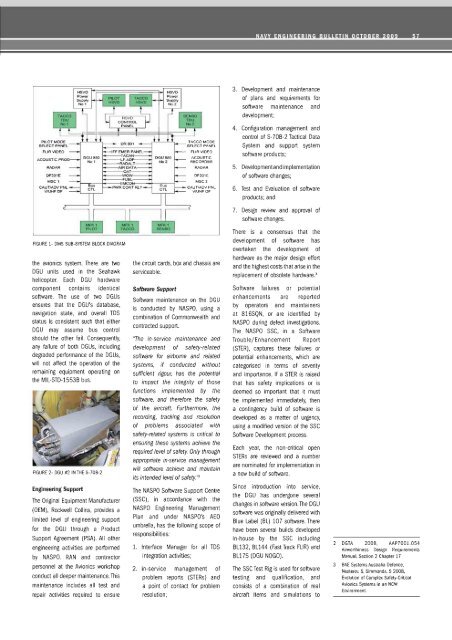ENGINE - Royal Australian Navy
ENGINE - Royal Australian Navy
ENGINE - Royal Australian Navy
Create successful ePaper yourself
Turn your PDF publications into a flip-book with our unique Google optimized e-Paper software.
OF301E<br />
MSC 1<br />
CAUTIAOV PNl<br />
V/UHF OF<br />
FIGURE 1- OMS SUB-SYSTEM BLOCK DIAGRAM<br />
the avionics system. There are two<br />
DGU units used in the Seahawk<br />
helicopter. Each DGU hardware<br />
component contains identical<br />
software. The use of two DGUs<br />
ensures that the DGU's database,<br />
navigation state, and overall TDS<br />
status is consistent such that either<br />
DGU may assume bus control<br />
should the other fail. Consequently,<br />
any failure of both DGUs, including<br />
degraded performance of the DGUs,<br />
will not affect the operation of the<br />
remaining equipment operating on<br />
the Mll-STD-1553B bus.<br />
FIGURE 2- DGU #2 IN THE S-70B-2<br />
Engineering Support<br />
The Original Equipment Manufacturer<br />
(OEM), Rockwell Collins, provides a<br />
limited level of engineering support<br />
for the DGU through a Product<br />
Support Agreement (PSA). All other<br />
engineering activities are performed<br />
by NASPO. RAN and contractor<br />
personnel at the Avionics workshop<br />
conduct all deeper maintenance. This<br />
maintenance includes all test and<br />
repair activities required to ensure<br />
FU RVIOEO<br />
ACOUSTIC<br />
RECORDER<br />
RADAR<br />
OF301E<br />
MSC 2<br />
CAUTIADV PNl<br />
VlUHF OF<br />
the circuit cards, box and chassis are<br />
serviceable.<br />
Software Support<br />
Software maintenance on the DGU<br />
is conducted by NASPO, using a<br />
combination of Commonwealth and<br />
contracted support.<br />
'The in-service maintenance and<br />
development of safety-related<br />
software for airborne and related<br />
systems, if conducted without<br />
sufficient rigour, has the potential<br />
to impact the integrity of those<br />
functions implemented by the<br />
software, and therefore the safety<br />
of the aircraft. Furthermore, the<br />
recording, tracking and resolution<br />
of problems associated with<br />
safety-related systems is critical to<br />
ensuring these systems achieve the<br />
required level of safety. Only through<br />
appropriate in-service management<br />
will software achieve and maintain<br />
its intended level of safety.'"<br />
The NASPO Software Support Centre<br />
(SSC). in accordance with the<br />
NASPO Engineering Management<br />
Plan and under NASPO's AEO<br />
umbrella, has the following scope of<br />
responsibilities:<br />
1. Interface Manager for all TDS<br />
integration activities;<br />
2. In-service management of<br />
problem reports (STERs) and<br />
a point of contact for problem<br />
resolution;<br />
3. Development and maintenance<br />
of plans and requirements for<br />
software maintenance and<br />
development;<br />
4. Configuration management and<br />
control of S-70B-2 Tactical Data<br />
System and support system<br />
software products;<br />
5. Developmentand implementation<br />
of software changes;<br />
6. Test and Evaluation of software<br />
products; and<br />
7. Design review and approval of<br />
software changes.<br />
There is a consensus that the<br />
development of software has<br />
overtaken the development of<br />
hardware as the major design effort<br />
and the highest costs that arise in the<br />
replacement of obsolete hardware.'<br />
Software failures or potential<br />
enhancements are reported<br />
by operators and maintainers<br />
at 816SQN, or are identified by<br />
NASPO during defect investigations.<br />
The NASPO SSC, in a Software<br />
Trouble/ Enhancement Report<br />
(STER), captures these failures or<br />
potential enhancements, which are<br />
categorised in terms of severity<br />
and importance. If a STER is raised<br />
that has safety implications or is<br />
deemed so important that it must<br />
be implemented immediately, then<br />
a contingency build of software is<br />
developed as a matter of urgency,<br />
using a modified version of the SSC<br />
Software Development process.<br />
Each year, the non-critical open<br />
STERs are reviewed and a number<br />
are nominated for implementation in<br />
a new build of software.<br />
Since introduction into service,<br />
the DGU has undergone several<br />
changes in software version. The DGU<br />
software was originally delivered with<br />
Blue label (Bl) 107 software. There<br />
have been several builds developed<br />
in-house by the SSC including<br />
Bl132, Bl144 (Fast Track FUR) and<br />
Bl1 75 (DGU NOGO).<br />
The SSC Test Rig is used for software<br />
testing and qualification, and<br />
consists of a combination of real<br />
aircraft items and simulations to<br />
DGTA 2008, AAP7001.054<br />
Airworthiness Design Requirements<br />
Manual, Section 2 Chapter 17<br />
3 BAE Systems Australia Defence,<br />
Nesterov. S, Simmonds. S 2008,<br />
Evolution of Complex Safety-Critical<br />
Avionics Systems in an NCW<br />
Environment.

















